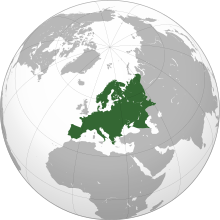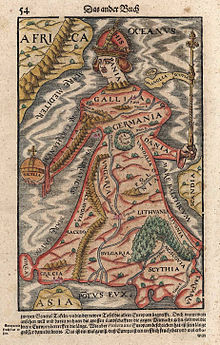Continental Europe

Continental Europeormainland Europeis the contiguousmainlandofEurope,excluding its surrounding islands.[1]It can also be referred to ambiguously as theEuropean continent,[2][3]– which can conversely mean the whole of Europe – and, by some, simply asthe Continent.[4]WhenEurasiais regarded as a single continent, Europe is treated both as acontinentandsubcontinent.[5]
Usage[edit]
The continental territory of the historicalCarolingian Empirewas one of the many old cultural concepts used for mainlandEurope.[6]This was consciously invoked in the 1950s as one of the basis for the prospectiveEuropean integration(see alsomulti-speed Europe)[7][8]
The most common definition of mainland Europe excludes thesecontinental islands:theGreek islands,Cyprus,Malta,Sicily,Sardinia,Corsica,theBalearic Islands,Great BritainandIrelandand surrounding islands,Novaya Zemlyaand the Nordic archipelago, as well as nearbyoceanic islands,including theCanary Islands,Madeira,theAzores,Iceland,theFaroe Islands,andSvalbard.[9]
TheScandinavian Peninsulais sometimes also excluded even though it is a part of "mainland Europe", as thede factoconnections to the rest of the continent were historically across theBaltic SeaorNorth Sea(rather than via the lengthy land route that involves travelling to the north of the peninsula where it meets Finland, and then south through northeast Europe).[9]TheØresund Bridgenow links the Scandinavian road and rail networks to those of Western Europe.

Great Britain and Ireland[edit]
In bothGreat Britainand Ireland,the Continentis widely and generally used to refer to the mainland of Europe.[citation needed]An amusing British newspaper headline supposedly once read, "Fog inChannel;Continent Cut Off ".[10]It has also been claimed that this was a regular weather forecast in Britain in the 1930s.[11]In addition, the wordEuropeitself is also regularly used to mean Europe excluding the islands of Great Britain, Iceland, and Ireland[citation needed](although the term is often used to refer to theEuropean Union[12]). The termmainland Europeis also sometimes used.[citation needed]Usage of these terms may reflect political or cultural allegiances, for example it has been observed that there is a correlation between whether a British citizen considers themselves "British" or "European" and whether they live in an area which primarily supportedBrexit.[13]
Derivatively, the adjectivecontinentalrefers to the social practices or fashion of continental Europe. Examples includebreakfast,topless sunbathing and, historically, long-range driving (before Britain hadmotorways) often known asGrand Touring.[citation needed]Differences include electrical plugs, time zones for the most part, the use ofleft-hand traffic,and for the United Kingdom, currency and the continued use of certainimperial unitsalongside themetric unitswhich have long since displaced customary units in continental Europe.[14][15]
Britain is physically connected to continental Europe through the underseaChannel Tunnel(the longest undersea tunnel in the world), which accommodates both theEurotunnel Shuttle(passenger and vehicle use – vehicle required) andEurostar(passenger use only) services. These services were established to transport passengers and vehicles through the tunnel on a 24/7 basis betweenEnglandand continental Europe, while still maintaining passport and immigration control measures on both sides of the tunnel. This route is popular with refugees and migrants seeking to enter the UK.[16]
[edit]

Especially inGermanic studies,continentalrefers to the European continent excluding theScandinavian Peninsula,Britain, Ireland, and Iceland. The reason for this is that although the Scandinavian peninsula is attached to continental Europe, and accessible via a land route along the66th parallel north,it is usually reached by sea.
Kontinenten( "the Continent" ) is a vernacular Swedish expression that refers to an area excludingSweden,Norway,andFinlandbut including Denmark (even theDanish Archipelagowhich is technically not a part of continental Europe) and the rest of continental Europe. In Norway, similarly, one speaks aboutKontinentetas a separate entity. In Denmark, Jutland is referred to as the mainland and thereby a part of continental Europe.
The Scandinavian Peninsula is now connected to the Danish mainland (theJutland Peninsula) by several bridges and tunnels.
Mediterranean and Atlantic islands[edit]
The Continentmay sometimes refer to thecontinental partof France (excludingCorsicaandoverseas France), thecontinental partof Greece (excluding theAegean Islands,Crete,and theIonian Islands), thecontinental partof Italy (excludingSardinia,Sicily,etc.), thecontinental partof Portugal (excluding theAzoresandMadeira), and thecontinental partof Spain (excluding theBalearic Islands,theCanary Islands,theplazas de soberanía,etc.). The term is used from the perspective of the island residents of each country to describe the continental portion of their country or the continent (or mainland) as a whole.
Metropolitan France is also known asl'Hexagone,"the Hexagon", referring to its approximate shape on a map. Continental Italy is also known aslo Stivale,"the Boot", referring to its approximate shape on a map. Continental Spain is referred to aspeninsular Spain.
See also[edit]
- Contiguous United States
- Continental philosophy
- Geographical midpoint of Europe
- Hajnal line
- Mainland
- Regions of Europe
References[edit]
- ^"Europe".Merriam Webster Dictionary.Archived fromthe originalon 22 April 2014.Retrieved5 May2019.
- ^Rosensteil, Francis (2001).Annuaire Europeen 2000 / European Yearbook 2000.Martinus Nijhoff Publishers. p. 69.ISBN9041118446.
- ^Robert, Jacques (2014).The European Territory: From Historical Roots to Global Challenges.Routledge. p. 183.ISBN9781317695059.
- ^"the Continent".Cambridge Dictionary.Cambridge University Press.Retrieved14 November2023.
- ^Baldwin, James A. (2014),"Continents",in R.W. McColl (ed.),Encyclopedia of World Geography,Infobase Publishing, pp. 214–216,ISBN978-0-8160-7229-3
- ^Heacock, Roger (13 December 2013)."Europe and Jerusalem:From Unholy Cacophony to Holy Alliance"(PDF).Institute for Palestine Studies.Archived(PDF)from the original on 15 January 2021.Retrieved11 February2021.
- ^Kaiser, Wolfram(2003)."Trigger-happy Protestant Materialists? The European Christian Democrats and the United States".InTrachtenberg, Marc(ed.).Between empire and alliance: America and Europe during the Cold War.Lanham, Md.: Rowman & Littlefield Publishers. pp. 67–69.ISBN978-0-585-45510-5.OCLC52451911.
- ^Hyde-Price, Adrian G. V. (2000).""Epochenwend:" unification and German grand strategy ".Germany and European order: enlarging NATO and the EU.Manchester, UK, New York: Manchester University Press: Distributed exclusively in the USA by St. Martin's Press. p.128.ISBN978-0-7190-5427-3.OCLC44851822– via Internet Archive.
- ^abMisachi, John (7 May 2019)."What Is Continental Europe?".WorldAtlas.Retrieved11 May2022.
- ^Oakley, Robin (19 April 2005)."Europe no star as election issue".CNN.Retrieved30 April2010.
- ^Sykes, Tom; Sykes, Simon, eds. (2 September 2009).Fog in Channel?: Exploring Britain's Relationship with Europe.Shoehorn Publishing.ASIN1907149066.
- ^Fraser, Douglas (15 August 2011)."Britain pushes hard choices for Europe's hard core".BBC News.
- ^O'Carroll, Lisa; Barr, Caelainn (11 April 2017)."Half of young adults in the UK do not feel European, poll reveals | Society | The Guardian".amp.theguardian.Retrieved26 June2022.
- ^"EU gives up on 'metric Britain'".BBC News.11 September 2007.Retrieved4 May2015.
- ^Kelly, Jon (21 December 2011)."Will British people ever think in metric?".BBC.Retrieved4 May2015.
- ^"France boosts Calais tunnel security".BBC News. 29 July 2015.
